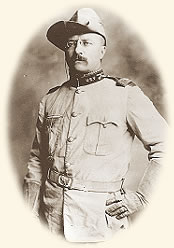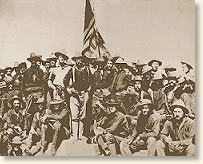|
The Rough Riders
Storm San Juan Hill, 1898
The charge up an obscure Cuban hill on July, 1 1898 was a pivotal point in Theodore Roosevelt's political career. When war broke with Spain in April of that year, Roosevelt was serving as Assistant Secretary of the Navy. He
 |
Teddy Roosevelt in
his Rough Riders uniform,
1898 |
immediately quit his position and helped form a regiment of volunteers. The "Rough Riders" enlisted cowboys and college men led by Roosevelt under the command of Leonard Wood. They arrived in Cuba in time to take part in the Battle of San Juan Hill.
America's conflict with Spain was later described as a "splendid little war" and for Theodore Roosevelt it certainly was. His combat experience consisted of one week's campaign with one day of hard fighting. "The charge itself was great fun" he declared, and "Oh, but we had a bully fight." His actions during the battle earned a recommendation for the Congressional Medal of Honor but politics intervened and the request was denied. The rejection crushed Roosevelt. As though in consolation, the notoriety from the charge up San Juan Hill was instrumental in propelling him to the governorship of New York in 1899. The following year Roosevelt was selected to fill the Vice Presidential spot in President McKinley's successful run for a second term. With McKinley's assassination in September 1901, Roosevelt became President.
In the confusion surrounding their departure from Tampa, half the members of the Rough Riders were left behind along with all their horses. The volunteers made the charge up San Juan Hill on foot. They were joined in the attack by the 10th (Negro) Cavalry. The 10th never received the glory for the charge that the Rough Riders did, but one of their commanders - Captain "Black Jack" Pershing (who later commanded American troops in World War I) - was awarded the Silver Star.
Richard Harding Davis was a reporter who observed the charge up San Juan Hill. We join his account as American forces have massed at the bottom of the hill - the Spanish entrenched in a dominate position on its top. Behind the Americans, advancing troops have clogged the roads preventing an escape. The Americans appear to be stymied - unwilling to move forward and unable to retreat. Suddenly, Theodore Roosevelt emerges on horseback from the surrounding woods and rallies the men to charge:
"Colonel Roosevelt, on horseback, broke from the woods behind the line of the Ninth, and finding its men lying in his way, shouted: 'If you don't wish to go forward, let my men pass, please.' The junior officers of the Ninth, with their Negroes, instantly sprang into line with the Rough Riders, and charged at the blue block-house on the right.
I speak of Roosevelt first because, with General Hawkins, who led Kent's division, notably the Sixth and Sixteenth Regulars, he was, without doubt, the most conspicuous figure in the charge. General Hawkins, with hair as white as snow, and yet far in advance of men thirty years his junior, was so noble a sight that you felt inclined to pray for his safety; on the other hand, Roosevelt, mounted high on horseback, and charging the rifle-pits at a gallop and quite alone, made you feel that you would like to cheer. He wore on his sombrero a blue polka-dot handkerchief, a la Havelock, which, as he advanced, floated out straight behind his head, like a guidon. Afterward, the men of his regiment who followed this flag, adopted a polka-dot handkerchief as the badge of the Rough Riders. These two officers were notably conspicuous in the charge, but no one can claim that any two men, or anyone man, was more brave or more daring, or showed greater courage in that slow, stubborn advance than did any of the others. . . .
I think the thing which impressed one the most, when our men started from cover, was that they were so few. It seemed as if someone had made an awful and terrible mistake. One's instinct was to call them to come back. You felt that someone had blundered and that these few men were blindly following out some madman's mad order. It was not heroic then, it seemed merely terribly pathetic. The pity of it, the folly of such a sacrifice was what held you.
They had no glittering bayonets, they were not massed in regular array. There were a few men in advance, bunched together, and creeping up a steep, sunny hill, the top of which roared and flashed with flame. The men held their guns pressed across their breasts and stepped heavily as they climbed. Behind these first few, spreading out like a fan, were single lines of men, slipping and scrambling in the smooth grass, moving forward with difficulty, as though they were wading waist high through water, moving slowly, carefully, with strenuous effort. It was much more wonderful than any swinging charge could have been. They walked to greet death at every step, many of them, as they advanced, sinking suddenly or pitching forward and disappearing in the high grass, but the others' waded on, stubbornly, forming a thin blue line that kept creeping higher and higher up the hill. It was as inevitable as the rising tide. It was a miracle of self-sacrifice, a triumph of bulldog courage, which one watched breathless with wonder. The fire of the Spanish riflemen, who still stuck bravely to their posts, doubled and trebled in fierceness, the crests of
 |
Roosevelt (center) and the
Rough Riders celebrate
at the top of San Juan Hill |
the hills crackled and burst in amazed roars, and rippled with waves of tiny flame. But the blue line crept steadily up and on, and then, near the top, the broken fragments gathered together with a sudden burst of speed, the Spaniards appeared for a moment outlined against the sky and poised for instant flight, fired a last volley and fled before the swift-moving wave that leaped and sprang up after them.
The men of the Ninth and the Rough Riders rushed to the blockhouse together, the men of the Sixth, of the Third, of the Tenth Cavalry, of the Sixth and Sixteenth Infantry, fell on their faces along the crest of the hills beyond, and opened upon the vanishing enemy. They drove the yellow silk flags of the cavalry and the Stars and Stripes of their country into the soft earth of the trenches, and then sank down and looked back at the road they had climbed and swung their hats in the air. And from far overhead, from these few figures perched on the Spanish rifle-pits, with their flags planted among the empty cartridges of the enemy, and overlooking the walls of Santiago, came, faintly, the sound of a tired, broken cheer."
References:
Davis, Richard Harding, The Cuban and Porto Rican Campaigns (1898); Freidel, Frank, The Splendid Little War (1958); Morris Edmund, The Rise of Theodore Roosevelt (1979).
How To Cite This Article:
"The Rough Riders Storm San Juan Hill, 1898," EyeWitness to History, www.eyewitnesstohistory.com (2004).
|






